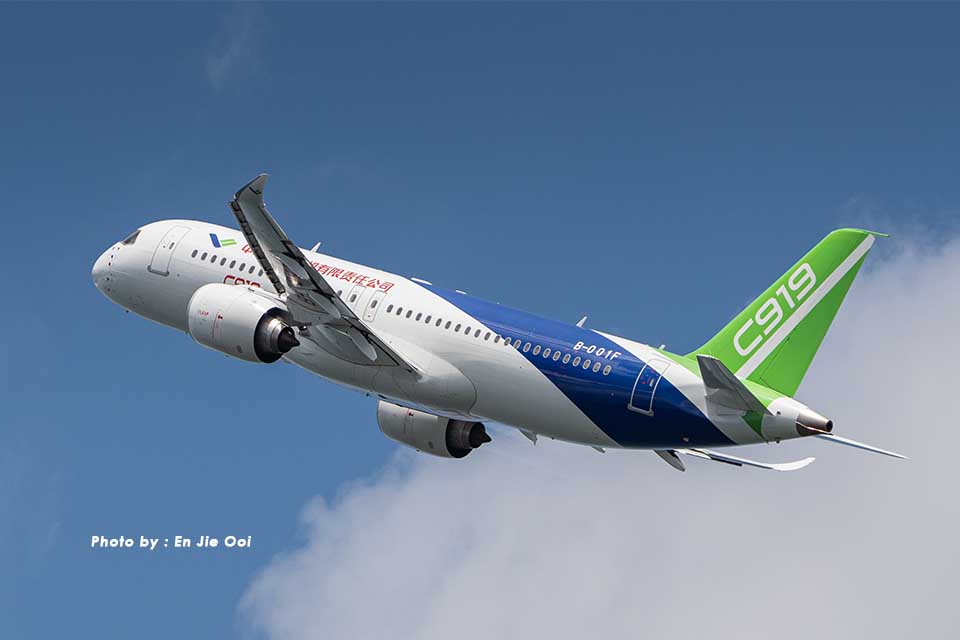Aviation
Comac C919 Moves Closer to Securing EU Certification with EASA

China’s first home-grown passenger jet, the C919, is edging closer to receiving certification from the European Union Aviation Safety Agency (EASA), following a crucial on-the-ground inspection by the regulator.
According to a report from the South China Morning Post, Chinese sources disclosed that EASA provided positive feedback after their second visit in July, a critical phase in the jet’s certification process.
During this visit, EASA inspectors engaged in hands-on evaluations using COMAC’s full-size level-D simulators, marking the third round of EASA’s four-step compliance demonstration process. This phase is particularly significant as it focuses on ensuring that the aircraft’s structure, electrical systems, and overall design meet stringent regulatory standards.
Aircraft comparisons between the comac C919 and the B737 max 8:Click here
The visit also included testing a Chinese-made complete flight simulator, which rivals the simulators used for the Airbus A320neo and Boeing 737 Max. comac c919 vs boeing 737 price
The positive feedback from EASA is a promising indicator, suggesting that the C919 may be on track for preliminary approval. While full certification remains distant, with European approval anticipated by 2025, this feedback is a critical milestone in the aircraft’s journey towards entering the international market.
Chinese media has expressed optimism about the C919’s progress, particularly as EASA has shown keen interest in the aircraft’s commercial operations within China. COMAC is expected to begin flight testing for EASA later this year or early next year, aligning with their goal of achieving full certification by 2025.
Is China’s COMAC C919 better than B737max and A319neo?:Click here
Currently, China Eastern Airlines, the only airline operating the C919, has seven of these jets in service, connecting major cities across five routes. As of the end of July, the C919 has flown 3,100 flights, carrying 420,000 passengers, underscoring its growing role in China’s aviation industry.
With EASA’s positive response and continued testing, the C919 is steadily moving closer to earning its place in the global aviation market, representing a significant achievement for China’s aerospace ambitions.

Aviation
COMAC Unveils Plans for the C929 to Rival Airbus and Boeing

After the success of China’s first C919 aircraft, the country is setting its sights on developing a larger plane. COMAC (Commercial Aircraft Corporation of China) has officially confirmed plans to build a widebody aircraft, marking a significant step in its aircraft lineup.
Traditionally, Airbus and Boeing dominate the widebody aircraft market, with decades of expertise in developing planes and engines capable of carrying heavy payloads. China, which currently relies on imported engines, is now aiming to challenge these giants with its own widebody jet, the C929, designed to compete with the Airbus A350 and Boeing 777.
American Airlines Is Looking for Flight Attendants: Apply Now
The C929 will be China’s first independently developed long-range widebody aircraft. It adheres to international airworthiness standards and boasts independent intellectual property rights. The baseline version is designed to seat 280 passengers and offers a range of 12,000 kilometers, catering to global demand for both regional and international air travel.
Russia, which also needs reliable narrowbody and widebody aircraft, could become a key customer for the C929. Additionally, China plans to target the broader Asian market as it continues to expand its aviation capabilities.
Close Call at Heathrow: BA Flight Narrowly Escapes Drone Collision
China’s aviation progress includes the ARJ21 (now called C909), a regional jet with 100 seats for shorter routes, and the C919, a narrowbody jet with 180 seats designed to rival the Boeing 737 MAX and Airbus A320. Both models have found increasing demand in the domestic market.
At China’s largest air show in Zhuhai, COMAC announced that Air China will be the launch customer for the C929 widebody jet, though details about order size and delivery timelines were not disclosed.
Other major deals announced by COMAC include:
- Hainan Airlines: Firm orders for 60 C919 and 40 C909 regional jets.
- Colorful Guizhou Airlines: 30 C909 jets, with 20 firm orders and 10 provisional agreements.
The C929, renamed from the CR929 after Russia withdrew from the joint development project in 2023, is expected to carry 280–400 passengers with a range of 12,000 kilometers, competing directly with Boeing’s 787 Dreamliner.
According to COMAC’s deputy general manager, Tong Yu, the first fuselage section of the C929 is expected by September 2027, with prototype test flights anticipated soon after.
-

 Aviation2 months ago
Aviation2 months agoMicrosoft Flight Simulator Raises $3 Million to Bring Back the An-225 Mriya
-

 Airlines2 months ago
Airlines2 months agoQantas Engineers Stage Walkout Over Cost of Living Concerns
-

 Airlines2 months ago
Airlines2 months agoQatar Citizens Can Travel to the United States Without a Visa
-

 Aviation2 months ago
Aviation2 months agoQatar Airways bans these new Electronic Devices on plane
-

 Airlines2 months ago
Airlines2 months agoJapan Airlines Rolls Out Free Domestic Flights to International Passengers
-

 Defence2 months ago
Defence2 months agoWhich Country Has the Largest Fleet of Fighter Aircraft?
-

 Airport2 months ago
Airport2 months agoWestern Sydney Airport Welcomes Its First Plane After 6 Years of construction
-

 Aviation2 months ago
Aviation2 months agoDid you know ? Once Boeing 747 carried 1088 passenger in 1991








